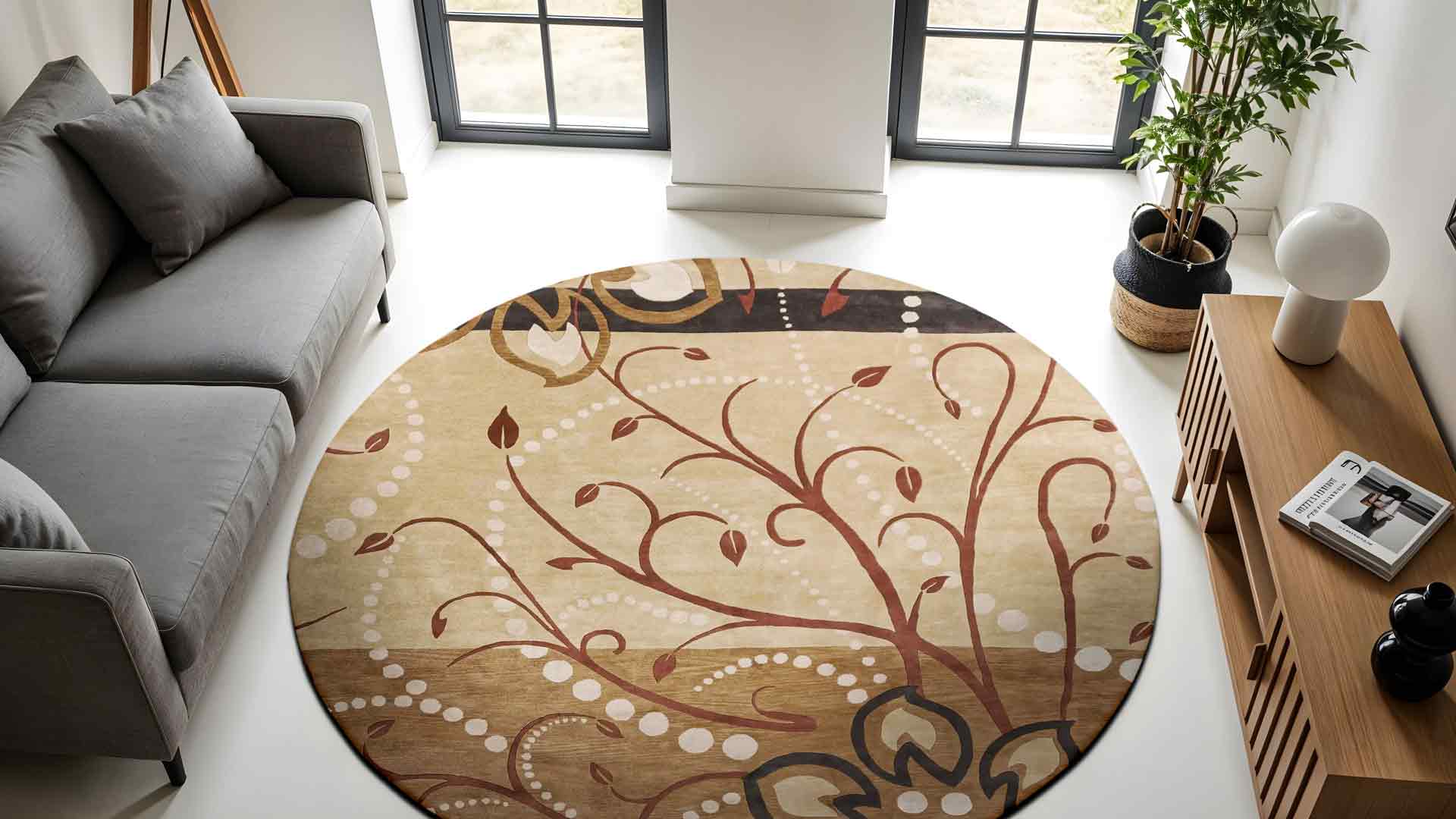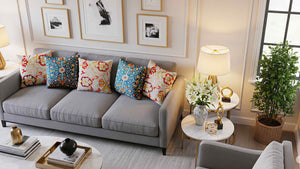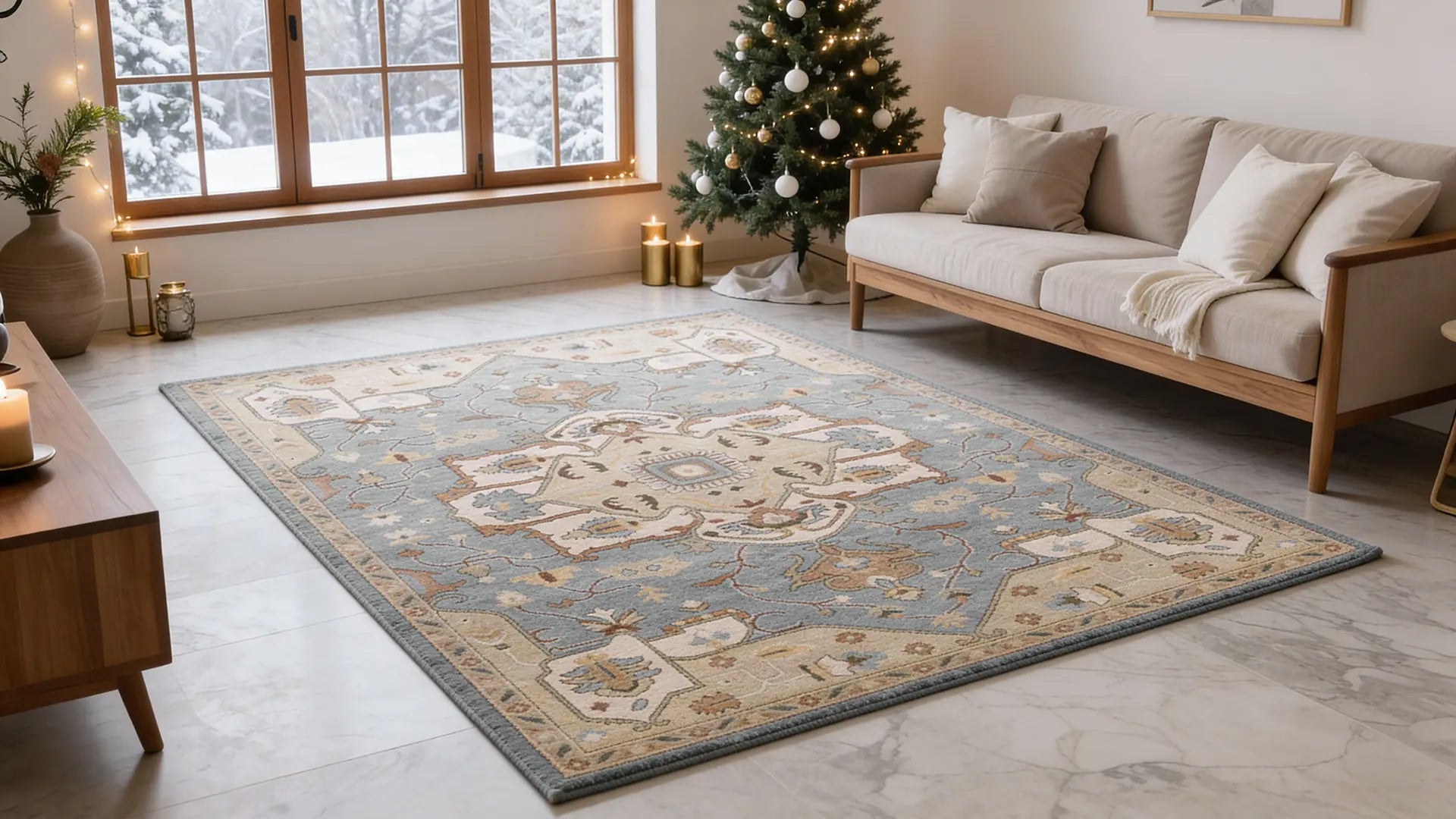Round rugs can instantly shift the energy of a room. Their curved shape softens sharp lines, adds visual flow, and brings warmth to even the simplest spaces.
Whether you're decorating a small apartment or a spacious living room, round rugs offer a stylish alternative to traditional rectangular options. From creating focal points to enhancing open layouts, they adapt easily to any design. This guide explores how to use round rugs for maximum impact—stylistically and functionally—in every room of your home.
Why Round Rugs Stand Out in Interior Design
Round rugs create flow. In rooms filled with straight lines and angles, circles stand out, providing contrast and visual interest. This balance brings warmth and softness—qualities that rectangular rugs don’t always deliver.
They also serve as natural focal points. Placing a round rug under a piece of furniture draws attention without overwhelming the layout. Whether it’s a coffee table, reading chair, or bed, round rugs help anchor the area and define purpose.
In open spaces, they create zones. If you have an open-plan layout, use a round rug to mark a conversation nook or dining area. The shape doesn’t interrupt sightlines, making the space feel connected but still functional.
Another benefit is versatility. Round rugs work well in both small and large rooms. They tuck into corners, highlight odd-shaped spaces, and add character where traditional shapes fail.
Lastly, they bring playfulness. Round forms feel less formal and more inviting. In kids' rooms, entryways, or creative spaces, round rugs make the environment feel relaxed and dynamic.
How Round Rugs Change The Vibe Of A Home:
1. Softening the Vibe and Adding Visual Interest
Breaking up harsh angles: Most rooms are built with straight lines—square walls, rectangular furniture, and sharp corners. A round rug introduces contrast. Its curved edges naturally soften the visual tension, making a space feel less rigid and more relaxed.
Adding softness and texture: Round rugs, especially in plush materials like wool or shag, enhance tactile comfort. Their texture and shape add warmth—both visually and physically—helping the room feel more lived-in and inviting.
Creating visual flow: Unlike rectangular rugs, round ones guide the eye in a circular motion. This prevents the gaze from getting stuck on straight edges. The result? A space that feels more dynamic and balanced.
Adding a focal point: A round rug placed at the center of a room, or beneath a specific piece of furniture, instantly commands attention. It grounds the space and draws focus to the core of the layout—whether that’s a coffee table, chair, or décor cluster.
2. Making Rooms Feel Bigger and More Open
Diverting attention: Round rugs encourage movement of the eye across the entire floor, rather than boxing attention into corners. This subtle shift makes even compact rooms feel more expansive.
Creating a sense of openness: The circular shape breaks the “grid” created by walls and furniture. This adds fluidity to the layout, especially beneficial in small or oddly shaped spaces. By avoiding hard stops, round rugs give the illusion of more breathing room.
3. Defining Spaces and Creating Zones
Creating distinct areas: In open-concept homes, visual zoning is essential. A round rug naturally defines separate functional areas without physical dividers. Use one under a reading chair, small table, or even a plant corner to create a purposeful mini-zone.
Defining a seating area: In a living room, a round rug beneath a central table pulls together scattered seating. This helps distinguish the seating area from the rest of the space and adds unity. It subtly encourages social interaction by forming a contained yet open circle.
This zoning approach works particularly well in studio apartments or multifunctional living areas.
4. Adding Versatility and Style
Blending with different styles: Round rugs are design chameleons. They work in classic interiors with ornate designs, minimalist spaces with solid neutrals, and eclectic rooms with bold prints. Their versatility lies in their ability to complement various aesthetics without overpowering them.
Adding a personal touch: Round rugs offer a chance to showcase personality. Whether it’s a handwoven circular jute rug or a bold geometric print, this shape adds visual flair that stands out from more common rectangular rugs.
Adding warmth and comfort: Beyond visuals, round rugs elevate comfort. Underfoot warmth, acoustic softness, and textural depth all contribute to a more welcoming atmosphere. Perfect for bedrooms, nurseries, or cozy corners that benefit from added comfort.
Best Places to Use Round Rugs for Maximum Impact
Round rugs can enhance almost any room, but placement is key. Their shape adds softness, but strategic placement maximizes both form and function. Here are the best areas to use round rugs—and why they work well.
Entryways
Entryways set the tone for your home, and a round rug creates a welcoming feel. The compact shape fits easily into small or circular foyers, where square rugs may not work. The curves soften hard floors and add character right at the door.
Since entryways get a lot of foot traffic, choose a durable material. Low-pile wool, jute, or synthetic blends are great for handling dirt and wear. A bold pattern can add interest and make a strong first impression. The rug also helps trap dirt and protect your floors.
Living Rooms
A round rug in the living room can anchor your furniture and make the space feel cohesive. It works well under a circular coffee table, mirroring the table’s shape for a unified look. It also softens the sharp lines of sofas and other rectangular pieces.
To avoid a disconnected look, choose a rug large enough to touch or sit under the front legs of surrounding furniture. This creates a visual connection and enhances the room’s flow. Round rugs are also great in corners or under accent chairs, adding texture without overwhelming the design.
Bedrooms
Bedrooms often have straight-edged furniture, from beds to nightstands. A round rug and carpets offers a break from these hard lines and brings calmness. Placing one partially under the bed helps frame it and provides a warm surface underfoot.
Another option is to place the rug beside the bed or in a reading corner to create a cozy zone. For bedrooms, plush or high-pile rugs in soft materials like wool are ideal. They add warmth and comfort, making the room feel more inviting.
Dining Areas
Dining areas are great spots for round rugs—especially with a round dining table. The similar shapes enhance symmetry and balance in the space.
When choosing a rug for a dining table, size matters. Make sure the rug is large enough for all chairs to stay on it, even when pulled out. This improves comfort and protects your floors. Materials like flatweave wool or stain-resistant synthetics work best, as they handle spills and frequent use well.
Round Rugs vs. Rectangular Rugs: Which Should You Choose?
Choosing the right rug shape is not just about design. It can change how a space feels and works. Rectangular rugs are the usual choice for most rooms. However, round rugs offer unique benefits that may fit your space better, depending on your layout and needs.
Rectangular rugs are popular for good reasons. They align easily with walls and furniture, making them great for defining spaces. Their straight lines help organize a room visually, especially in large, open areas. Whether under a sofa, dining table, or bed, a rectangular rug provides full coverage and structure. They work well in narrow hallways and long rooms, where their shape matches the room’s proportions.
Round rugs, on the other hand, add softness and a relaxed feel. Their curved edges break the straight lines, making them perfect for areas that need a softer touch. Round rugs are great for small rooms. They work well under circular furniture, like dining tables. They also add contrast in spaces with angular pieces. They also help create a sense of space, as the circular shape keeps the eye moving and avoids harsh stops.
When to Choose a Round Rug:
-
In small rooms that feel tight or boxed in
-
When a space has many straight lines and needs balance
-
Under round or curved furniture like coffee or dining tables
-
To add a sense of playfulness or break visual monotony
When to Choose a Rectangular Rug:
-
In long or rectangular rooms where alignment is key
-
Under sectionals or large furniture for complete coverage
-
When you want to clearly define zones in an open-plan space
-
For high-traffic areas like hallways or formal layouts
Both shapes offer their own strengths. The key is to match the rug shape with your room’s function and overall design goals. Sometimes, even layering the two can create depth and style that bridges the best of both worlds.
Read also: Round Rugs: The Perfect Blend of Style and Comfort
Design Tips for Styling with Round Rugs
Round rugs add a unique shape and softness to a space. To make them shine, they need to be styled with purpose. Here are some tips to help you get the most from your round rug.
1. Layer for Texture and Contrast
Layering adds depth and texture. Placing a round rug over a larger, neutral rectangular rug can create contrast while grounding the design. This works well in living rooms and bedrooms where you want visual interest without overwhelming the space.
2. Choose the Right Size
Size matters. A common mistake is choosing a round rug that’s too small. Make sure some key furniture pieces—like a coffee table, chair legs, or the edge of a bed—are touching the rug. This connection helps unify the space and prevents the rug from looking like an afterthought.
3. Create Balance in Angular Rooms
Balance is key when mixing shapes. Use round rugs to soften rooms with many square or angular elements, like boxy sofas or straight-edged tables. This contrast creates a more inviting atmosphere.
4. Play with Color and Pattern
Choose colors and patterns based on your design goals. If your room is neutral, a bold pattern or bright color on a round rug can stand out. If the room is busy, an earthy tone or subtle texture will add softness without clutter.
5. Pick the Right Material for the Room
Choose materials based on how the room is used. Wool is warm and soft, perfect for cozy areas like bedrooms. Jute is durable and adds an organic touch—great for high-traffic spaces. Synthetic options are practical for families or pets due to their stain resistance and easy care.
6. Keep the Surroundings Minimal
Round rugs look best with space around them. Avoid cluttering the area with too much furniture or decor. Let the rugs and carpets be a focal point rather than getting lost in a busy layout. This clean approach allows the shape to shine and creates a more open feel in the room.
Final Thoughts: Shaping a Space with Style
Round rugs are a simple way to upgrade a room’s look and feel. They add balance, contrast, and warmth—qualities that impact mood and style.
Whether you're working with a studio apartment, a grand entryway, or a cozy bedroom, round rugs adapt. Their shape brings flow, making spaces feel connected, calm, and complete.
Choose the right size, place it with purpose, and your round rug will do more than decorate—it will transform.












